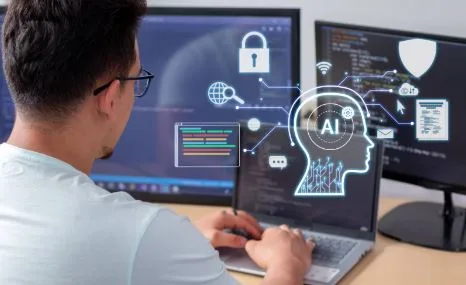7 Smart Ways AI Computers Are Making Learning Equal for Everyone
Learning is the foundation of growth, but not everyone gets the same chance to learn. In many parts of the world, students still struggle because of a lack of teachers and tools.
According to UNESCO, more than 244 million children and youth were out of school in 2023.
AI computers are now fixing that gap. They use smart algorithms and real time data to create lessons that fit every learner. These machines don’t just repeat content, they learn from how students learn and adjust to their pace. From AI tutors to language translation systems, technology is making education accessible to every student.
This article will take a deeper look at seven smart and technical ways AI computers are making learning equal for all.
1. NLP-Powered Tools Breaking Language Barriers
One of the biggest hurdles in education is language. AI computers solve this using natural language processing, a branch of AI known as NLP, which helps computers understand and translate human language. The in-built NLP tools in the device can convert lectures, e-books, and notes to any other language in a matter of seconds.
How NLP Makes Global Learning Possible
- AI converts both text and speech into any target language.
- Voice recognition in the laptop supports practicing pronunciation accurately.
- Automatic subtitles help students follow complex lessons.
NLP breaks language barriers so that every student, regardless of their background, has access to education of the same high standards.
2. Adaptive Learning Engines That Personalize Lessons
Every student learns differently, and that’s where AI-driven adaptive learning engines come in. Through machine learning algorithms, these systems study how a student interacts with lessons, tracking speed, accuracy, and response time to understand learning behavior. Based on this, they’ll automatically adjust lesson difficulty.
For instance, adaptive learning platforms like DreamBox or Smart Sparrow build models that update with every student response. The goal is simple: to give every learner the right challenge level.
Technical Edge That Makes Learning Smarter
- AI engines use pattern recognition to detect weak areas.
- Neural networks predict which concept a student is likely to struggle with next.
- Real-time feedback enables students to correct mistakes immediately.
In such adaptive systems, no one feels left behind; no one gets bored. Learning becomes equally engaging for all.
3. Cloud-Based AI Platforms Enabling Anytime Learning
Whereas students once learned their lessons in classrooms, today cloud-based AI learning systems make lessons available anywhere and anytime, utilizing distributed servers for data storage that can be accessed from any device.
AI computers can track a student’s learning progress and integrate data across devices through cloud integration, allowing a student to start a math lesson on their laptop and then continue it on their phone without losing any work.
Tech That Powers 24/7 Learning
- Cloud servers store personalized learning pathways
- AI bots offer live tutoring via chat or video.
- Edge computing ensures smooth learning even on low internet.
4. Assistive AI Systems for Students with Disabilities
AI is not just smart; it’s inclusive. Assistive AI systems incorporate speech recognition, computer vision, and predictive text algorithms to support students with disabilities in their learning.
Image recognition models, for instance, ensure that AI readers like Microsoft’s Seeing AI describe visual content to blind students. The system converts speech to text, which helps those who struggle with typing. In fact, several of these features make classrooms more accessible and equal.
- Text-to-speech and speech-to-text AI models
- Visual captioning using deep learning
- Predictive keyboard systems that complete words quickly.
With the help of such technologies, AI computers help every learner overcome challenges and stay active in learning.
5. AI-Powered Analytics That Support Teachers
Teachers have to spend hours and hours checking papers and tracking grades. AI computers now perform this task more quickly and accurately. With data analytics, predictive modeling sets scores of immediate assessments of student performance.
AI data visualization enables platforms like IBM Watson Education to pinpoint exactly where students struggle the most, freeing teachers from paperwork to spend their time guiding students more effectively.
Tech Features that Save Teaching Time
- AI algorithms analyze class performance trends.
- Auto-grading systems reduce manual correction.
- Predictive analytics alerts teachers to struggling students
With AI supporting them, teachers can give personalized guidance and work on improving results rather than managing reports.
6. Virtual Simulations That Build Real-World Skills
AI computers bring simulation-based learning into the classroom. The systems utilize a combination of machine vision, 3D modeling, and real-time rendering to provide virtual environments that enable students to test their knowledge.
In science, AI-powered labs enable students to conduct experiments safely without resorting to physical tools. In coding, AI simulators guide students through logic errors and debugging in real-time.
- 3D AI labs for science and engineering
- AI mentors explain every step of each experiment.
- Data tracking that measures problem-solving progress
It is such simulations that turn theory into practice and make education equal and interactive.
7. Edge AI Devices Closing the Digital Divide
Access to technology still separates many students, a gap that AI computers with Edge AI capability can finally resolve. Edge AI refers to a system that processes data locally, independent of strong internet connectivity.
This helps rural schools utilize AI tools on limited bandwidth. Low-cost devices powered by AI chips, such as Google’s Tensor or NVIDIA Jetson, bring high-quality learning to even the most remote places.
Tech Behind Equal Access
- Edge AI enables offline learning through local computation.
- Low-power AI chips reduce device cost.
- Cloud sync updates progress when the Internet reconnects
Thanks to Edge AI, every student, whether in a city or a small village, has the same access to digital education tools.
The Last Word
AI computers are collaborators in building a more inclusive education for all, not merely tools. From adaptive learning to NLP and Edge AI devices, technology is turning classrooms into connected learning spaces.
The systems independently track progress, translate content, and guide students step-by-step through lesson and activity procedures to give everyone an equal chance to succeed in their academic pursuits.
The education gap may still persist, but AI is closing it each day with smarter models and accessible systems. With each upgrade, learning becomes more personal, inclusive, and balanced. The future of equal education is not far, it’s already being built by AI computers today.




